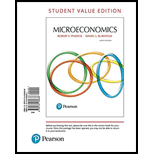
The difference between the short-run and long-run production function.
Explanation of Solution
The production function is the process of transformation of inputs into outputs, which lead to value addition. A production function determines the maximum quantity of outputs that can be produced with the given quantity of inputs. A short run refers to a time period in which only a single factor of production is variable. Thus, a short-run production function refers to the maximum quantity of output that can be produced by changing the quantity of the variable factor. The long run is a time period in which all the factors of production can be changed. Thus, the long-run production function refers to the maximum quantity of outputs that can be produced by changing all the factors of production.
Production function: Production functions express the relationship between inputs and outputs assuming that there is no change in technology.
Short run: Short run refers to the time period in which only a single factor of production changes, and the others remain fixed.
Long run: Long run refers to the time period in which all the factors of production change.
Want to see more full solutions like this?
Chapter 6 Solutions
Microeconomics, Student Value Edition Plus MyLab Economics with Pearson eText -- Access Card Package (9th Edition) (Pearson Series in Economics)
- Find the equation of the price offer curve and demand curve for the following utility function: U= min (3x, 2y). Let income of the consumer be M, price of good X is Px and price of good Y be Py. Also draw both the curves. (b) Let utility function of a consumer be given by U(x,y) = xy + x, where X and Y are the two goods (i) Is marginal rate of substitution diminishing? (ii) Are marginal utilities of both goods X and Y diminishingarrow_forwardx, y) = 2√x + y. Let price of X be $0.50, price of Y be $1 and income is $10. (i) Find initial equilibrium of the consumer. (ii) Find the new equilibrium if price of X falls to $0.20. (iii) Using Hicksian technique decompose the price effect into substitution and income effectsarrow_forwardPrice elasticity by the hour of day. Average parking occupancy rates of 2011 (i.e., after the rate change) in neighborhoods with a decrease, no change and an increase in rates are also displayed in this figure. 0.0 -0.1 E I -0.2 a S -0.3 t i -0.4 C i -0.5 t Y -0.6 -0.7 -0.8 Hour of the day 60 8 9 10 11 12 13 14 15 16 17 -0.9 -Decrease price elasticities model 1 → Decrease neighborhoods' occupancy in 2011 ...... No price change neighborhoods' occupancy in 2011 Increase price elasticities model 1 ⚫ Increase neighborhoods' occupancy in 2011 50 8333PONG> 40 40 30 20 20 a n C Y 30 10 0 (0°) ૪ Based on the figure showing estimated elasticities after the price increase, what times of day have the most elastic parking demand? Why do you think this is the case? Explain.arrow_forward
- Financial analysis 2022, 2023, and 2024 for O' Reilly's trends in dataarrow_forward9-5. In a replacement analysis for a vacuum seal on a spacecraft, the following data are known about the challenger: the initial investment is $12,000; there is no annual maintenance cost for the first three years, however, it will be $2,000 in each of years four and five, and then $4,500 in the sixth year and increasing by $2,500 each year thereafter. The salvage value is $0 at all times, and MARR is 10% per year. What is the economic life of this challenger? (9.5)arrow_forward9-4. A vehicle costs $30,000 and incurs maintenance costs. increasing by $500 annually, starting at $1,000 in year one. When is it economical to replace it, assuming no salvage value? Use a MARR = 8% per year.arrow_forward
- 9-14. Analyze the replacement of an old crane with $7,000 annual maintenance and a $30,000 current market value with a new one for $100,000 and $2,000 annual maintenance. The MARR is 15% per year.arrow_forward9-15. A small high-speed commercial centrifuge has the following net cash flows and abandonment values over its useful life (Table P9-15, p. 454). The firm's MARR is 12% per year. Determine the optimal time for the centrifuge to be abandoned if its current MV is $9,500 and it won't be used for more than five years. (9.8)arrow_forwardBalance sheet, income statement and statement of cash flow 2022, 2023, and 2024 for AutoZone and trend analysisarrow_forward
- 9-1. An existing machine with a book value of $10,000 has maintenance costs of $2,000 per year. A new machine costs $25,000 with annual maintenance costs of $500. When should the existing machine be replaced? The company's MARR is 15% per year.arrow_forward9-3. Analyze replacing a commercial oven with $800 annual maintenance and a $3,000 salvage value with a new one for $15,000 and $300 annual maintenance. The company's MARR is 12% per year.arrow_forward6. If D(p) = 100/p and c(y) = y2, what is the optimal level of output of the monopolist?arrow_forward
 Economics (MindTap Course List)EconomicsISBN:9781337617383Author:Roger A. ArnoldPublisher:Cengage Learning
Economics (MindTap Course List)EconomicsISBN:9781337617383Author:Roger A. ArnoldPublisher:Cengage Learning
 Exploring EconomicsEconomicsISBN:9781544336329Author:Robert L. SextonPublisher:SAGE Publications, Inc
Exploring EconomicsEconomicsISBN:9781544336329Author:Robert L. SextonPublisher:SAGE Publications, Inc Microeconomics: Principles & PolicyEconomicsISBN:9781337794992Author:William J. Baumol, Alan S. Blinder, John L. SolowPublisher:Cengage Learning
Microeconomics: Principles & PolicyEconomicsISBN:9781337794992Author:William J. Baumol, Alan S. Blinder, John L. SolowPublisher:Cengage Learning





